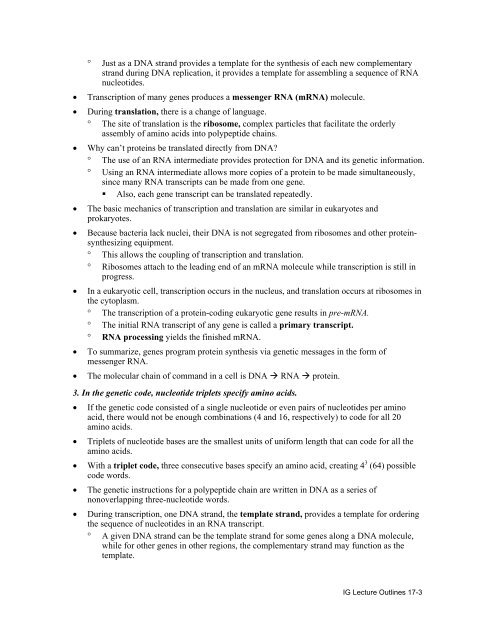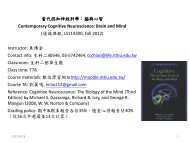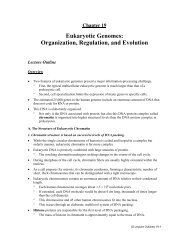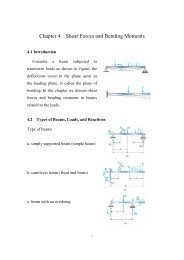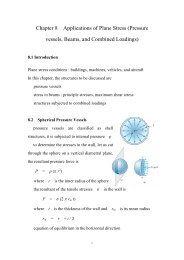CHAPTER 17 FROM GENE TO PROTEIN
CHAPTER 17 FROM GENE TO PROTEIN
CHAPTER 17 FROM GENE TO PROTEIN
- No tags were found...
Create successful ePaper yourself
Turn your PDF publications into a flip-book with our unique Google optimized e-Paper software.
° Just as a DNA strand provides a template for the synthesis of each new complementarystrand during DNA replication, it provides a template for assembling a sequence of RNAnucleotides.• Transcription of many genes produces a messenger RNA (mRNA) molecule.• During translation, there is a change of language.° The site of translation is the ribosome, complex particles that facilitate the orderlyassembly of amino acids into polypeptide chains.• Why can’t proteins be translated directly from DNA?° The use of an RNA intermediate provides protection for DNA and its genetic information.° Using an RNA intermediate allows more copies of a protein to be made simultaneously,since many RNA transcripts can be made from one gene.• Also, each gene transcript can be translated repeatedly.• The basic mechanics of transcription and translation are similar in eukaryotes andprokaryotes.• Because bacteria lack nuclei, their DNA is not segregated from ribosomes and other proteinsynthesizingequipment.° This allows the coupling of transcription and translation.° Ribosomes attach to the leading end of an mRNA molecule while transcription is still inprogress.• In a eukaryotic cell, transcription occurs in the nucleus, and translation occurs at ribosomes inthe cytoplasm.° The transcription of a protein-coding eukaryotic gene results in pre-mRNA.° The initial RNA transcript of any gene is called a primary transcript.° RNA processing yields the finished mRNA.• To summarize, genes program protein synthesis via genetic messages in the form ofmessenger RNA.• The molecular chain of command in a cell is DNA RNA protein.3. In the genetic code, nucleotide triplets specify amino acids.• If the genetic code consisted of a single nucleotide or even pairs of nucleotides per aminoacid, there would not be enough combinations (4 and 16, respectively) to code for all 20amino acids.• Triplets of nucleotide bases are the smallest units of uniform length that can code for all theamino acids.• With a triplet code, three consecutive bases specify an amino acid, creating 4 3 (64) possiblecode words.• The genetic instructions for a polypeptide chain are written in DNA as a series ofnonoverlapping three-nucleotide words.• During transcription, one DNA strand, the template strand, provides a template for orderingthe sequence of nucleotides in an RNA transcript.° A given DNA strand can be the template strand for some genes along a DNA molecule,while for other genes in other regions, the complementary strand may function as thetemplate.IG Lecture Outlines <strong>17</strong>-3


